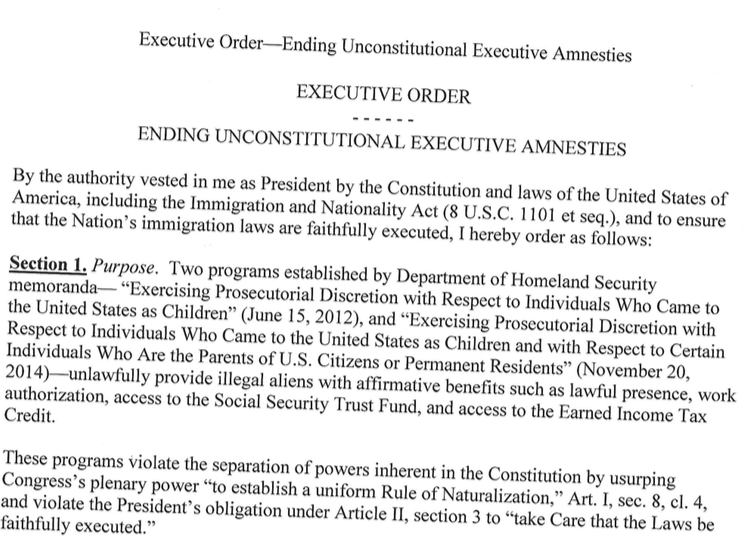One week into the Trump Administration, despite all of the other executive actions taken with respect to immigration, DACA and DAPA are still on the books. Indeed, DHS is still accepting DACA applications. Yet, the pieces seem to be in place not only to suspend those policies, but also repudiate the grounds on which they were issue. In the President’s executive order on “Enhancing Public Safety in the Interior of the United,” there are six references to “faithful execution.”
“order to ensure the public safety of the American people in communities across the United States as well as to ensure that our Nation’s immigration laws are faithfully executed”
“We cannot faithfully execute the immigration laws of the United States if we exempt classes or categories of removable aliens from potential enforcement.”
“Ensure the faithful execution of the immigration laws of the United States, including the INA, against all removable aliens”
“Make use of all available systems and resources to ensure the efficient and faithful execution of the immigration laws of the United States”
“I hereby direct agencies to employ all lawful means to ensure the faithful execution of the immigration laws of the United States against all removable aliens”
“Enforcement Priorities. In executing faithfully the immigration laws of the United States, the Secretary of Homeland Security (Secretary) shall prioritize for removal those aliens described by the Congress”
The import of these statements is unmistakeable: the prior President’s actions were not faithful executions of the law. As a constitutional matter, I agree. (See my various amicus briefs, and articles making that point).
Bolstering this conclusion is a leaked draft memorandum, surfaced by Vox, which recommends the President rescind DAPA and DACA in light of the Take Care Clause.

Here we have yet another case where the President, pursuant to his own oath of office, interprets the Constitution without judicial guidance. If my students learn anything from me, the courts do not have a monopoly on interpreting the Constitution. But it is not enough to withdraw the DAPA and DACA policies.
Formalizing this decision, however, would also entail rescinding the November 2014 OLC Opinion that gave the green light to DAPA and DACA. Section 5 of the proposed executive order does just that, instructing the Justice Department to not rely on that memo:

This step is short of OLC formally withdrawing the memo, as a future administration could (in theory at least) simply rescind the instant executive order, and choose to follow the opinion authored by Obama appointee Karl Thompson. The far-more preferable solution would be to ask OLC to take a second look at this opinion, and revisit it in light of the 5th Circuit’s opinion in U.S. v. Texas, the discover from Judge Hanen’s court about how much “discretion” was actually used, and even my articles criticizing the factual errors made by OLC). There is ample ground to determine the November 2014 opinion can no longer stand.
So far, there has not been any movement from OLC concerning DAPA and DACA. Carrie Johnson reported that DOJ would not comment if the OLC had approved the White House’s orders. “No comment,” they said. This is a non-story, as OLC seldom publicly comments on advice it provides to the President. Only a handful of opinions are actually published on the OLC web site. Former OLC chiefs Caroline Krass and Karl Thompson admitted that fewer and fewer formal opinions are sought to avoid FOIA requests.
This is a mistake. Unless an opinion has national security implications or classified information, there is no valid reason why the people should not be aware of the government’s constitutional justifications for their actions. My friend Alan Morrison is currently litigating this issue, arguing they should all be released under FOIA. But, they are not. For example, the Office informally “orally advised” the administration concerning DACA, which we only learned about in a footnote for the DAPA opinion. Nor did the office release any opinion concerning hostilities in Libya–indeed, they opted not to reduce the opinion to writing because the President wasn’t going to follow it. Charlie Savage reported in Power Wars:
The not-hostilities rationale the administration put forward was controversial, even before the administration made it public. Other lawyers on Obama’s team did not endorse Bauer’s and Koh’s interpretation of the War Powers Resolution. Johnson told Bauer he was sticking with what he said in his discussion paper. Krass made clear that if Bauer asked the Office of Legal Counsel to write a formal, authoritative memo analyzing the question, she was unlikely to give the White House the answer it wanted to hear. DeRosa, who was subordinate to Bauer, kept her head down; her position was also in a state of flux, as she was slated to step down and hand over the role of National Security Council legal adviser to her deputy, Avril Haines, in early June. Late in the process, Holder— who had the authority to override the Office of Legal Counsel and come up with the official Justice Department interpretation of the law himself— told the White House that he was backing Krass. But Obama had already made the decision by then, and Holder registered the point mildly.
If indeed OLC was not consulted before these orders were issued–notwithstanding any public commentary–it would be, well, sad. The office has been defenestrated and degraded over the last sixteen years. I hope that in the Trump Administration, it makes a modicum of credibility.